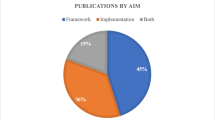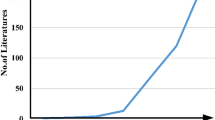Abstract
Digital Twin (DT) is envisioned as a critical technology to revolutionize the manufacturing and maintenance of real-life gadgets shortly. It is a system collection that goes beyond traditional simulation and analysis techniques. It converts a physical system’s components, operations, dynamics, and firm-ware into a digital equivalent. Physical and digital systems share all inputs, outputs, and processes via real-time data connections and information transmission. Digital twins’ models speed up human user efficiency, reduce wear on real-world systems, and promote creativity and innovation while posing the fewest operational risks in industry 5.0. We have discussed Digital Twins’ concept, applications, methodologies, and research scope in detail in this paper. The study contains a systematic review of the architecture and operation of digital twins along with a contextual taxonomy of application domains like manufacturing, healthcare, and smart cities.
Access this chapter
Tax calculation will be finalised at checkout
Purchases are for personal use only
Similar content being viewed by others
References
Brosinsky, C., Westermann, D., Krebs, R.: Recent and prospective developments in power system control centers: adapting the digital twin technology for application in power system control centers. In: 2018 IEEE International Energy Conference (ENERGYCON), pp. 1–6 (2018). https://doi.org/10.1109/ENERGYCON.2018.8398846
Chakraborti, A., Heininen, A., Väänänen, S., Koskinen, K.T., Vainio, H.: Evidential reasoning based digital twins for performance optimization of complex systems. Procedia CIRP 104, 618–623 (2021). https://doi.org/10.1016/j.procir.2021.11.104. https://www.sciencedirect.com/science/article/pii/S2212827121010027. 54th CIRP CMS 2021 - Towards Digitalized Manufacturing 4.0
Chen, X., Kang, E., Shiraishi, S., Preciado, V.M., Jiang, Z.: Digital behavioral twins for safe connected cars. In: Proceedings of the 21th ACM/IEEE International Conference on Model Driven Engineering Languages and Systems, MODELS 2018, pp. 144–153. Association for Computing Machinery, New York (2018). https://doi.org/10.1145/3239372.3239401
Gahlot, S., Reddy, S.R.N., Kumar, D.: Review of smart health monitoring approaches with survey analysis and proposed framework. IEEE Internet Things J. 6(2), 2116–2127 (2019). https://doi.org/10.1109/JIOT.2018.2872389
Jo, S.K., Park, D.H., Park, H., Kim, S.H.: Smart livestock farms using digital twin: feasibility study. In: 2018 International Conference on Information and Communication Technology Convergence (ICTC), pp. 1461–1463 (2018). https://doi.org/10.1109/ICTC.2018.8539516
Laaki, H., Miche, Y., Tammi, K.: Prototyping a digital twin for real time remote control over mobile networks: application of remote surgery. IEEE Access 7, 20325–20336 (2019). https://doi.org/10.1109/ACCESS.2019.2897018
Liu, Y., et al.: A novel cloud-based framework for the elderly healthcare services using digital twin. IEEE Access 7, 49088–49101 (2019). https://doi.org/10.1109/ACCESS.2019.2909828
Lv, Z., Cheng, C., Song, H.: Digital twins based on quantum networking. IEEE Network 36(5), 88–93 (2022). https://doi.org/10.1109/MNET.001.2200131
Mohammadi, N., Taylor, J.E.: Thinking fast and slow in disaster decision-making with smart city digital twins. Nature Comput. Sci. 1(12), 771–773 (2021)
Rudskoy, A., Ilin, I., Prokhorov, A.: Digital twins in the intelligent transport systems. Transp. Res. Procedia 54, 927–935 (2021). https://doi.org/10.1016/j.trpro.2021.02.152. https://www.sciencedirect.com/science/article/pii/S235214652100332X. International Scientific Siberian Transport Forum - TransSiberia 2020
Tao, F., Qi, Q., Wang, L., Nee, A.: Digital twins and cyber-physical systems toward smart manufacturing and industry 4.0: correlation and comparison. Engineering 5(4), 653–661 (2019). https://doi.org/10.1016/j.eng.2019.01.014. https://www.sciencedirect.com/science/article/pii/S209580991830612X
Wen, J., Yang, J., Li, Y., He, J., Li, Z., Song, H.: Behavior-based formation control digital twin for multi-aug in edge computing. IEEE Trans. Network Sci. Eng., 1–11 (2022). https://doi.org/10.1109/TNSE.2022.3198818
Xu, Y., Sun, Y., Liu, X., Zheng, Y.: A digital-twin-assisted fault diagnosis using deep transfer learning. IEEE Access 7, 19990–19999 (2019). https://doi.org/10.1109/ACCESS.2018.2890566
Yang, R., Er, P.V., Wang, Z., Tan, K.K.: An rbf neural network approach towards precision motion system with selective sensor fusion. Neurocomputing 199, 31–39 (2016). https://doi.org/10.1016/j.neucom.2016.01.093. https://www.sciencedirect.com/science/article/pii/S0925231216003593
Zhang, M., Tao, F., Huang, B., Nee, A.: A physical model and data-driven hybrid prediction method towards quality assurance for composite components. CIRP Annals 70(1), 115–118 (2021). https://doi.org/10.1016/j.cirp.2021.04.062. https://www.sciencedirect.com/science/article/pii/S000785062100086X
Zheng, Z., Qiu, H., Wang, Z., Luo, S., Lei, Y.: Data fusion based multi-rate kalman filtering with unknown input for on-line estimation of dynamic displacements. Measurement 131, 211–218 (2019). https://doi.org/10.1016/j.measurement.2018.08.057. https://www.sciencedirect.com/science/article/pii/S0263224118307966
Author information
Authors and Affiliations
Corresponding author
Editor information
Editors and Affiliations
Rights and permissions
Copyright information
© 2023 The Author(s), under exclusive license to Springer Nature Singapore Pte Ltd.
About this paper
Cite this paper
Mazumder, A., Banerjee, P.S., Karmakar, A., Ghosh, P., De, D., Song, H. (2023). Digital Twin for Industry 5.0: A Vision, Taxonomy, and Future Directions. In: Bhattacharyya, S., Banerjee, J.S., De, D., Mahmud, M. (eds) Intelligent Human Centered Computing. Human 2023. Springer Tracts in Human-Centered Computing. Springer, Singapore. https://doi.org/10.1007/978-981-99-3478-2_22
Download citation
DOI: https://doi.org/10.1007/978-981-99-3478-2_22
Published:
Publisher Name: Springer, Singapore
Print ISBN: 978-981-99-3477-5
Online ISBN: 978-981-99-3478-2
eBook Packages: Intelligent Technologies and RoboticsIntelligent Technologies and Robotics (R0)




